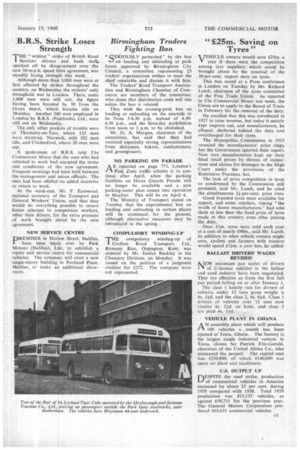"25m. Saving on Tyres"
Page 39

If you've noticed an error in this article please click here to report it so we can fix it.
VEHICLE owners would save £25m. a year if there were the competition among tyre suppliers which could be brought about by the removal of the 30-per-cent, import duty on tyres.
This was stated at a Press conference in London on Tuesday by Mr. Richard Lamb, chairman of the tyres committee of the Free Trade Union. As reported in The Commercial Motor last week, the Union are to apply to the Board of Trade in February for the removal of the duty.
He recalled that this was introduced in 1927 to raise revenue, but today it merely kept imports out, and manufacturers, he alleged, sheltered behind the duty and overcharged for their tyres.
The Monopolies Commission in 1955 revealed the 'manufacturers' price rings, but the Government ignored their report. Now tyre manufacturers kept up their fixed retail prices by threats of injunctions and claims for damages in the High Court under, the provisions of the Restrictive Practices Act.
The lack of price competition in tyres so condemned by the Commission still persisted, said Mr. Lamb, and he cited the simultaneous If-per-cent, price rises.
Good branded tyres were available for import, and some retailers, risking "the wrath of home manufacturers," had sold them at less than the fixed price of tyres made in this country even after paying the duty.
Over. I lm. tyres were sold each year at a cost of nearly £90m., said Mr. Lamb. In addition to what vehicle owners might save, cyclists and farmers with tractors would spend £31m. a year less, he added.
BALLAST DRIVERS' WAGES REVISED
NEW minimum pay scales of drivers of C-licence vehicles in the ballast and sand industry have been negotiated. They are effective as from the first full pay period falling on or after January 1.
The class I hourly rate for drivers of vehicles under 12 tons gross weight is 4s. lid. and the class 2, 4s. Old. Class I drivers of vehicles over 12 tons now 'receive 4s. 2RI. an hour, and class 2 are paid 4s. 1.;:d.
VEHICLE PLANT IN GHANA
AN assembly plant which will produce 100 vehicles a , month has been opened at Tema, Ghana. The factory is the largest single industrial venture in Tema, claims Sir Patrick Fitz-Gerald, chairman of the United Africa Co., who pioneered the project. The capital cost was £250,000, of which £140,000 was spent on plant and machinery.
U.S. OUTPUT UP
DESPITE the steel strike, production of commercial vehicles in America increased by about 25 per cent. during 1959 compared with 1958. Total 1959 production was 813,135 vehicles, as against 650,711 for the previous year. The General Motors Corporation produced 403.631 commercial vehicles.












































































































